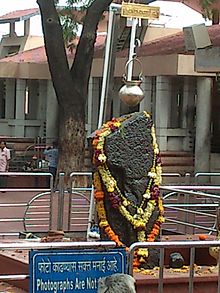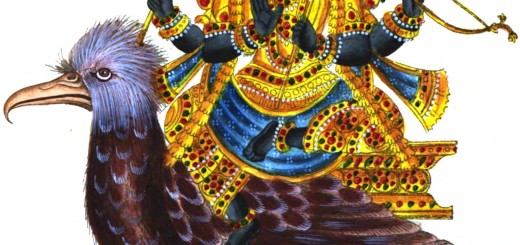Shani Shingnapur Temple in Maharashtra

This five and half feet stone emerged from earth. Devotees believe that Shani Deva (Saturn God) resides in this stone.
Shani Shingnapur is a village in Maharashtra. Its claim to fame is its temple dedicated to Shani Dev (Saturn). Shingnapur is about 35 km from Ahmednagar city.
No house or shop in this village has doors. They only have door frames. People believe that Shani will safeguard their valuables so they don’t feel the need to lock things up. No theft had been reported from this village until 2010. However, since then there have been a couple of thefts. Homes still have no doors. Those who committed thefts reportedly died vomiting blood before they could cross the village. Others became ill or went mad.
The Shani Temple at Shingnapur is a jagrut devasthan. That means the deity still resides in the idol. They believe that Shani will punish anyone attempting theft. The deity here is “Swayambhu”. No one made it – it emerged from the earth in the form of a black, imposing stone.
The crime rate in the region is near-zero. In January 2011, UCO Bank made news when it opened a lockless branch in the village.
The legend
The idol of Shani worshipped at this temple is believed to have emerged from earth. The story goes like this: A group of shepherds were passing through the area around the present temple. When one of them touched the stone that had emerged from earth with a pointed rod, it started bleeding. Of course, they were astounded. People gathered to watch the miraculous happening. That night Lord Shani appeared in the dream of the most devoted shepherd. He told the shepherd that he is Shanaishwara (Lord Shani) and that the black stone is his form. With great respect and devotion, the shepherd asked the Lord if he would like them to build a temple for him. To this, Lord Shani replied that there was no need for a roof over his idol as the whole sky was his roof. He instructed the shepherd to perform Pooja daily. On every Saturday, the shepherd was also asked to perform ‘Tailabhisheka’ (bathe the idol in oil). He also promised to protect the whole village from theft. The temple still has no roof. The shops and homes have no doors either. Even the post office does not have a door, let alone locks.
The idol is a five and half feet high black rock standing on an open air platform. In addition to Shani, Lord Shiva, Hanuman and Nandi (celestial bull) are also worshipped here.
The temple receives around 30,000 – 45,000 visitors a day. That number swells to about 3,00,000 on Amavasya (the new moon day). New moon days that fall on Saturdays are even more special. A festival honoring the deity is organized on Amavasya.
How to reach
Shani Shingnapur is well-connected by road and rail. It is about 35 kilometres from Ahmadnagar city and 84 kilometers from Aurangabad. Pune is about 160 kilometers away. The nearest railway station is Srirampur. Shani Shingnapur is about 265 kilometers from Mumbai. Shani Shingnapur is a major pilgrimage center in Maharashtra. It is halfway between Shirdi and Aurangabad, two major pilgrimage centers in Maharashtra. Shani Shingnapur is about 65 kilometers from Shirdi and Aurangabad. Many people visiting Shirdi also visit Shingnapur.
Why women aren’t allowed inside the inner sanctum?
Women cannot enter the inner sanctum of this temple and make offerings to the deity. They have access to the other parts of the temple. They are agitating against this ban. While a court verdict on this row is yet to come, spiritual leader Sri Sri Ravi Shankar has pledged his support to women. In his opinion, the gender bias has no spiritual sanction.
The Indian Constitution does not support gender bias. Women have the same constitutional rights as women. However, gender equality is still a distant dream in religious matters. The country is dotted with temples and dargahs (Muslim places of worship) that keep women out.
In the Vedic society, women enjoyed the same status as men. They were allowed to learn scriptures and perform pujas. If one reads epics like Ramayana and Mahabharata, it is not hard to see that women had a greater say than men in several matters. The status of of women eventually diminished and men became the custodians of religion. At some point women were not even allowed to chant Gayatri Mantra.
Things have definitely improved after the country won independence. The current row over the entry of women has more to do with fear than gender bias. Centuries ago, a few people dictated that women be banned from entering the sanctum sanctorum of the Shani Temple. This practice is still followed. Villagers are worried that if this age old custom is broken, bad things may happen. They even went to the extent of saying that men will be banned too. The logic is simple – if women insist on entering the sanctum because men are entering, banning the male folk as well will solve the problem, right? If men can’t enter, will women insist that they should be allowed inside?
